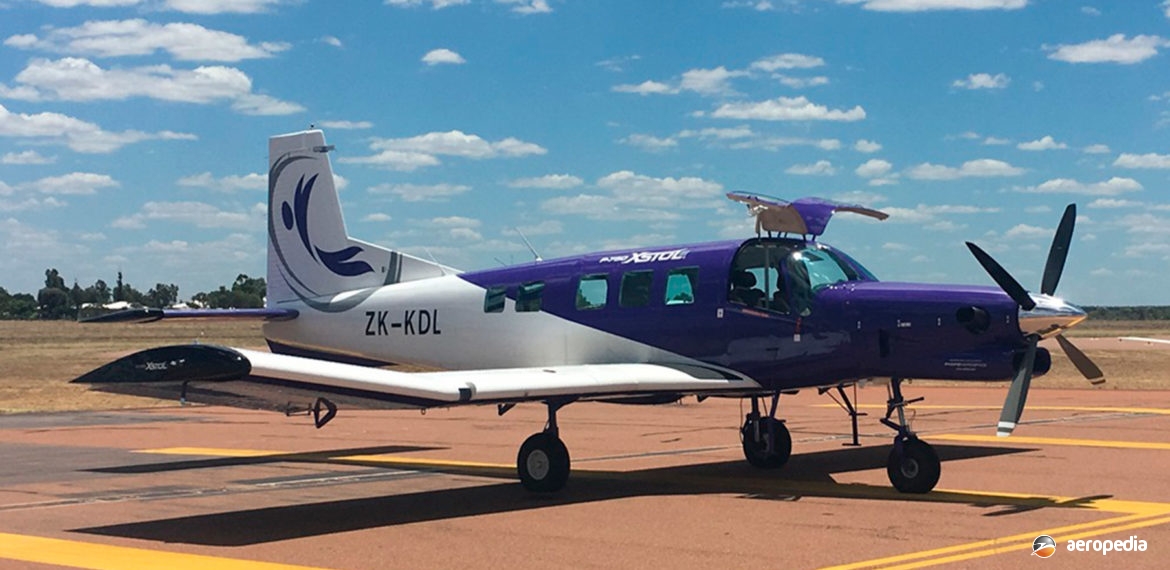Photograph:
PAC 750 XSTOL ZK-KDL (c/n 208) at Longreach, QLD in February 2019 (CQ Plane Spotting)
Country of origin:
New Zealand
Description:
Light single-engine utility aircraft
Power Plant:
One Pratt & Whitney Canada PT6A-34 turboprop
Specifications:
- Wingspan: 12.8 m (42 ft)
- Length: 11.84 m (38 ft 8 in)
- Height: 4.04m (13 ft 4 in)
- Wing area: 28.34 m² (305 sq ft)
- Never exceed speed: 315 km/h (196 mph)
- Max speed at 3048 m (10,000 ft): 309 km/h (192 mph)
- Design cruising speed: 259 km/h 161 mph)
- Max manoeuvring speed: 243 km/h (151 mph)
- Max flap extension speed: 222 km/h (138 mph)
- Stalling speed with flaps: 107 km/h (66 mph)
- Max rate of climb: 325 m/min (1067 ft/min)
- Climb to 3,658 m (12,000 ft): 14 mins
- Max operating altitude: 6,096 m (20,000 ft)
- Service ceiling: 7,620 m (25,000 ft)
- Take-off roll at sea level: 220 m (721 ft)
- Landing roll at sea level: 166 m (543 ft)
- Take-off distance to 15 m (50 ft): 458 m (1,503 ft)
- Landing distance from 15 m (50 ft): 289 m (950 ft)
- Max range at 4,572 m (15,000 ft): 2,183 km (1,356 miles)
- Endurance with auxiliary fuel: 10 hrs
- Fuel capacity: 1,256 litres (276 Imp gals)
- Max range with auxiliary tank, 387 litres (85 Imp gals) usable: 2,593 km (1,611 miles)
- Empty weight: 1,633 kg (3,600 lb)
- Useful load: 1,769 kg (3,900 lb)
- Loaded weight: 3,420 kg (7,540 lb)
History:
The PAC 750 series, as noted elsewhere, was developed from the Cresco agricultural series of aircraft, which itself was developed from the Fletcher FU-24 series. The type received US FAA certification in 2004 and was basically targeted at the skydiving role, the high-lift wings and high power-to-weight ratio permitting the aircraft to climb with a load of parachutists to 3,700 m (12,000 ft) and return in ten minutes. After more than 100 examples had been delivered to operators around the world for a variety of purposes development has continued to increase performance.
Examples were subsequently built for the utility role, passenger operations, aerial photograph and survey work, a few being fitted with magnetic anomaly detectors for geo-survey work. Works has taken place to fit variants with skis and floats but no examples so fitted have been completed. Examples have also been delivered to operators involved in United Nations Humanitarian work.
In 2016 Oceania took over Pacific Aircraft Corporation and renamed the manufacturer Pacific Aviation Limited and under the new ownership the first aircraft was delivered nine months later in 2007. The name of the aircraft was then changed to PAC 750 XSTOL (Extreme STOL). As the type has become more popular production in 2017 was increased to 24 aircraft per year, most aircraft being built to meet the requirements of the purchaser. A variant known as the Defender II has been developed for counter-insurgency and light attack operations.
In the passenger role up to nine passengers can be carried, and a cargo pod has been made available for attachment under the belly of the aircraft. It can be configured as all-passenger, all-cargo or a combination of both and all variants have double cargo doors. Certification has been received for single-engine IFR commercial passenger transport operations.
On 1 March 2017 it was announced the first PAC 750 XSTOL for the Papua New Guinea Defence Force would arrive in Port Moresby later in that month, with a further three aircraft to be delivered during 2017. The aircraft were ordered to meet the Government’s requirements for its air transport wing, the Defence Force at that time operating a fixed-wing aircraft and two helicopters on lease, these aircraft being funded by the Australian Government. The new aircraft are expected to carry troops, supplies and provide surveillance.
On 10 March 2004 the US Federal Aviation Administration certified PAC 750 XSTOL under Part 23, the development program for the aircraft involving many changes and by that time the wings, ailerons, flaps, fuel system had all been revised for the new aircraft. The aircraft is designed to operate with a 1,814 kg (4,000 lb) payload from rough terrain and is able to perform at high altitude, in hot weather, and from semi-prepared airstrips. Passenger configuration is now ten and a 453 kg (1,000 lb) cargo pod can be attached to the under belly. The seats can be removed to provide 6.79 m³ (240 cub ft) of space, or hold 17 skydivers or six pairs of tandem skydivers.
In mid 2018 PAC was testing and developing a new variant of the 750 series known as the Super Pac and at that time was fulfilling orders from Poland, four aircraft for the Papua New Guinea Defence Force, and five for the China Administration of Sports organisation for skydiving 116 examples of the series having been completed at that time. To meet the competition of the Cessna Caravan with the Garrett TPE 331 engine, the Super Pac is fitted with a 670 kw (900 shp) Pratt & Whitney PT6A-140A engine driving a hartzell four-blade propeller 2.7 m (108 in) in diameter, this reducing time to climb to 3,962 m (13,000 ft) by up to 27 percent and fuel burn to that altitude by up to 23 percent.

